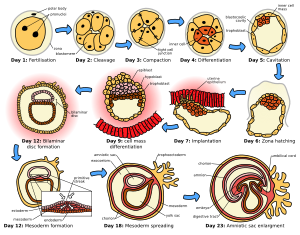Human embryonic development facts for kids
Human embryonic development is the amazing journey of how a human embryo grows and forms. It involves tiny cells dividing and changing to become different parts of the body. In simple terms, it's about how a single cell grows into a complete human being.
This process begins with fertilization. This happens when a sperm cell successfully joins with an egg cell (also called an ovum). The special genetic material from both the sperm and the egg then combine. This forms a single new cell called a zygote. This marks the very beginning, or "germinal stage," of development.
The first eight weeks of a human's development are called the embryonic stage. After these eight weeks, the embryo is then called a fetus. There are 23 different steps or stages during these first eight weeks.
Human embryology is the study of all these changes that happen during the first eight weeks after fertilization. A normal pregnancy, or gestation, usually lasts about nine months, which is around 40 weeks.
The Very Beginning: Germinal Stage
The germinal stage is the time from fertilization until the early embryo attaches itself to the wall of the uterus. This attachment is called implantation. This stage usually lasts about 10 days.
During this time, the single-celled zygote starts to divide very quickly. This process is known as cleavage. As it divides, it forms a tiny ball of cells called a blastocyst. This blastocyst then travels to the uterus and implants there.
Forming Body Parts: Embryogenesis
After the germinal stage, embryogenesis continues with a process called gastrulation. During gastrulation, the embryo forms three main layers of cells. These layers are called germ layers. Each layer will later develop into specific parts of the body. This process of forming different tissues is called histogenesis.
Following gastrulation, two other important processes happen:
- Neurulation: This is when the early nervous system, including the brain and spinal cord, starts to form.
- Organogenesis: This is when all the different organs of the body begin to develop.
From Embryo to Fetus
Once the embryo reaches the ninth week of development, it is called a fetus. Compared to an embryo, a fetus has more clear and recognizable body features. It also has a more complete set of developing organs.
The entire process of embryogenesis is very complex. It involves many changes that happen in a specific order and at specific times. These changes include how gene expression works, how cells grow, and how they change into specialized cells (this is called cellular differentiation).
Similar processes of development happen in many other living things, especially in animals with backbones, known as chordates.


